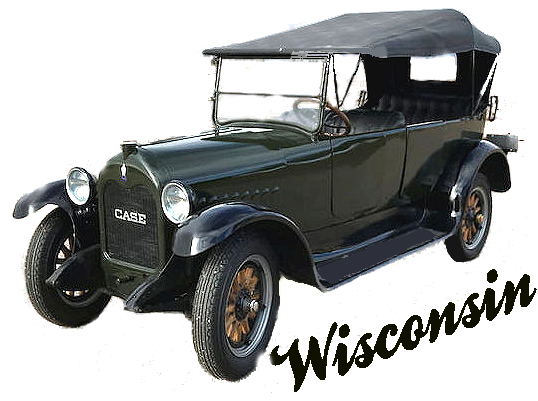


Mobile users:
For best results, view in Landscape mode.
Did you know?
The first true automotive
HVAC system ( heating,
ventilation, and air conditioning )
was introduced in
Wisconsin by the Nash Motors
Company of Kenosha.
For more info,
The Four-Wheel Drive
(FWD):
In 1909, the Badger Four-Wheel Drive
Auto Company was founded in
Clintonville, Wisconsin by William
Besserdich and Otto Zachow.
They developed and produced the
first simple and effective design for
transferring power to all 4 wheels
of an automobile.
In 1910, the name was changed
to the Four-Wheel Drive
Auto Company.
And in 1958, the name changed
again to the FWD Corporation.
FWD Corporation also had produced
fire apparatus under its own brand,
and supplied heavy duty chassis
to a number of apparatus builders
throughout the U.S. and Canada.
In 1881, Fredric Seagrave founded
Seagrave in Detroit, Michigan.
The company moved to Columbus,
Ohio in 1891 and remained there
until 1963.
In 1963, FWD Corporation purchased
Seagrave Fire Apparatus who then
moved all their operations to
Clintonville, Wisconsin where it
still remains today.
FWD Seagrave is the oldest continuous
manufacturer of fire equipment
in the U.S.
The Speedometer:
In 1901, the Oldsmobile Curved Dash
Runabout came equipped with a
"mechanical" speedometer.
Overland and Cadillac were the
next to provide speedometers
in their automobiles.
These early speedometers were
hard to read and had no
illumination for night viewing.
But, Arthur P. Warner the original
founder of the many incarnations
of Warner Electric, claimed the
rights to the first invention of
a speedometer for the automobile.
Arthur P. Warner, was a self-taught
engineer. 1870 - 1957
The Warner Instrument Co. of
Beloit, Wis., founded in 1903,
later became the Stewart-Warner
Company.
Arthur P. Warner, holder of more
than 100 patents, invented a
speed-measuring device for
industrial cutting tools, called
the "Cut-Meter" to serve as a speed
indicator for industrial machinery.
He then adapted this technology
for the automobile.
Mr. Warner was also the first American
private citizen to purchase an
airplane, the "first commercially
built airplane".
He paid Glenn Curtiss $6000 for a
disassembled one.
Once he had assembled it,
(without instructions or manuals)
he became the first person to
fly in Wisconsin, at Beloit on
November 4, 1909.
He got 50 feet off the ground and
traveled a quarter mile.
He was one of the first ten Americans
to fly an airplane anywhere.
Arthur P. and Charles H. Warner,
two brothers from Beloit, Wis.,
filled this need with their patented
"auto-meter," which provided drivers
not only with accurate readings
of speeds up to 60 mph, but also
kept track of the distances their
cars had gone.
The Warners brought to market
the first speedometer to combine
both speed and distance indicators
into a single instrument, and
later also added a clock and lighted
dials to some models of their
auto-meter.
Warner became the largest
speedometer manufacturer after
World War I.
After the end of World War I, the
Warner Instrument Company placed
9 out of every 10 speedometers
in automobiles.
In addition to their speedometer
success, the Warner brothers
continued to invent and market
many other products such as auto
and truck trailers, electric brakes
and clutches, basing many of their
businesses out of Beloit.
As part of their interest in advertising
and association with timing
instruments, the Warners also
served as official timers of the
early days of the Indianapolis
500 race for several years.
The winner of the Indy 500 still receives
the Borg-Warner Trophy to this day.
One competitor, the Stewart and
Clark Company of Chicago, abandoned
its centrifugal model speedometers
and started to manufacture magnetic
based speedometers based
closely on the Warner model.
The Warners sued for patent
infringement and eventually won,
but still sold their company to
Stewart and Clark in 1912 for
$1.2 million.
The new company reorganized as
Stewart-Warner and by the 1920's
Warner magnetic speedometers
became standard equipment on over
90% of the automobiles manufactured
in the United States.
The Stewart-Warner Auto Meter
was more accurate and durable
than competitor versions and quickly
became an industry standard for
most automobiles.
Mr. Warner later became president
of the Warner-Patterson Company
and in 1955 was made chairman
of the board.
Warner Electric still services the
automotive industry today by
providing industrial clutches and
brakes, along with sensors, switches
and tensioner systems.
They are headquartered in South
Beloit, IL, just south of the
Wisconsin border.
